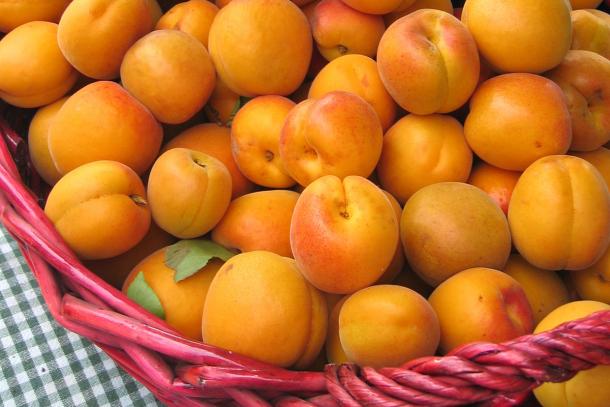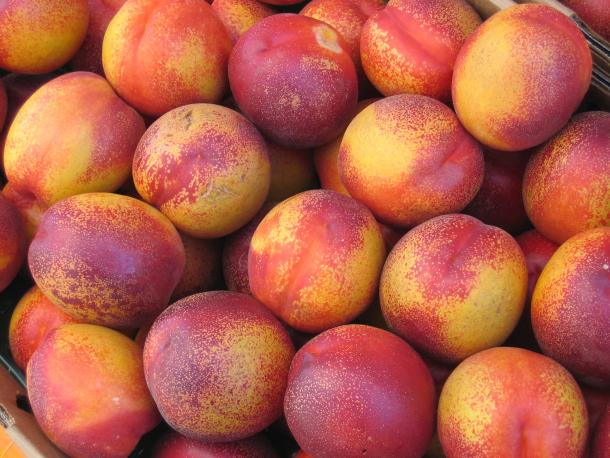While Karl the Fog envelops the Bay Area, stone fruit brings a ray of sweet sunshine to the summer farmers market, in a rainbow of colors and flavors.
Between a freshly harvested farmers market peach and a common grocery store peach, you’ll find a world of difference. In the grocery store distribution system, fruit is often picked early, before the sugars are able to fully develop, in order to withstand long-distance shipping and retail storage. This results in mealy peaches that lack flavor. In contrast, farmers market peaches are picked shortly before market, making them more perishable but also perfectly ripe, juicy, and ready to eat.
Cherries, apricots, peaches, and plums are commonly known as “stone fruit,” referring to the hard pits that cover their seeds. These members of the genus Prunus consist of flowering trees bearing fleshy, pitted fruits known as drupes. Freestone drupes have flesh that can be easily separated from the seeds, while clingstone fruits are messier but often juicier and more flavorful. Almonds also fall in the Prunus camp, though it’s the seed rather than the flesh that we eat.
Since most stone fruit varieties have a brief harvest window, each week brings new surprises, with favorites like Rainier cherries, O’Henry peaches, and Flavor Grenade pluots making cameos throughout the season. Here’s a quick guide to stone fruit from the farmers market.

Cherries (April-July): The earliest of the stone fruit, cherries demand prompt and quick consumption, with their relatively brief season and short shelf-life. There exists an array of flavors of colors, from lushly sweet to pleasantly tart, and from rich crimson (Bing, Brooks, Tulare) to blushing sunshine (Rainier). When shopping for cherries, seek out firm, plump fruit with unblemished skin and the stem intact. Cherries are highly perishable and will not ripen once picked, so eat them as soon as possible to get the best flavor.

Apricots (May-July): With their gold-orange velvety skin, these dense-fleshed flavor bombs are a late spring/early summer delicacy. Their easy-to-remove pit makes for easy snacking. One of the most sought-after local apricots, the Royal Blenheim, was introduced to California in the 1880s, and by the 1920s the variety dominated a thriving dried apricot industry, blanketing the Santa Clara Valley. Most of the original Blenheim orchards have been paved over, but a few farmers, such as Bill Crepps of Everything Under the Sun, still grow the intensely flavorful variety, available in limited supply in June.

Peaches (May-September): At the height of summer, peaches have an intoxicating aroma and an almost too-good-to-be-real flavor—it’s no wonder some peach fans make the trip to the farmers market just for them. Thousands of varieties exist, and each one has its own personality. Some people prefer the pure, low-acid sugariness of a white peach, while others live for the tart/sweet flavor of a classic yellow peach. The sweetness of a peach also depends on how ripe it was when harvested. A peach will get juicier and softer as it ripens on a kitchen counter, but it will have only the amount of sugar it started with when it was picked. What changes is the chemistry; the acid content decreases as the fruit ripens, and so the fruit tastes sweeter.

Nectarines (May-September): Nectarines are actually cultivars of peaches. They are of the same species, but due to a recessive gene, they do not develop the characteristic fuzz (a protection against insects) of a peach, and instead have a smooth skin. The mutation also leads to a firmer, spicier tasting flesh. Like peaches, nectarines can be either freestone or clingstone, depending on how embedded the pit is within the flesh.

Plums (May-November): Over 2,000 varieties of plums exist, each with a diverse set of shapes and colors, and they are divided into the following six categories: Japanese, American, Ornamental, Damson, Wild, and European. Japanese plums are the most familiar and widely sold fresh-eating plum, typically round or heart-shaped with a dark red or peachy-yellow flesh. The natural whitish coating on many plums (and other plants) is epicuticular wax, or “bloom,” and it serves as a water repellant and protection against moisture loss and UV light.


